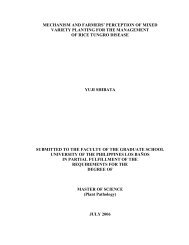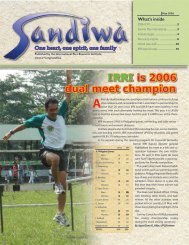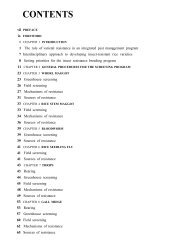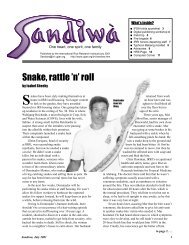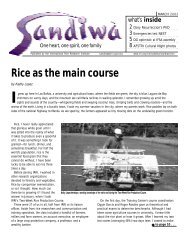Untitled - International Rice Research Institute
Untitled - International Rice Research Institute
Untitled - International Rice Research Institute
You also want an ePaper? Increase the reach of your titles
YUMPU automatically turns print PDFs into web optimized ePapers that Google loves.
Fig. 9. Occurrence of brown spot (Ou 1985, Agarwal and Mathur 1988, EPPO 1997).<br />
it Cochliobolus miyabeanus. Because of the bipolar<br />
germination of the conidia, the anamorph of C.<br />
miyabeanus was changed to Bipolaris oryzae.<br />
d. Importance in crop production<br />
Bipolaris oryzae causes seedling blight, necrotic<br />
spots on leaves and seeds, and also grain discoloration.<br />
Severely infected seeds may fail to germinate.<br />
Seedling blight is common on rice in both<br />
rainfed lowlands and uplands. Under these rice<br />
production situations, brown spot can be a serious<br />
disease causing considerable yield loss. In history,<br />
the Bengal famine of 1942 is attributed to brown<br />
spot.<br />
Detection on seed<br />
a. Incubation period on blotter<br />
B. oryzae is easily observed on seeds using the<br />
blotter method 5 d after seeding on moistened<br />
blotter incubated under NUV light at 22 °C. The<br />
detection frequency is about 56.7% on seeds coming<br />
from different regions (Fig. 10a,b).<br />
b. Habit character<br />
There are two types of fungal detection on rice<br />
seed: type I shows less conidia and abundant<br />
aerial mycelia, fluffy to cottony; gray, greenish<br />
gray to black; conidiophores are usually slender<br />
and hard to distinguish from main mycelia;<br />
conidia are darker than mycelia, borne singly on<br />
the terminal portion of the hyphae.<br />
Type II shows abundant conidia and aerial<br />
mycelia are either absent or scanty. Conidiophores<br />
are straight or flexuous, relatively long;<br />
simple, brown to dark brown, arising directly from<br />
seed surface either solitary or in small groups<br />
bearing conidia at the end and/or on the sides,<br />
usually with 3–5 conidia per conidiophore (Fig.<br />
11a-c).<br />
c. Location on seed<br />
B. oryzae is often observed on the entire seed<br />
surface (about 32%) or on sterile lemmas (about<br />
29%) (Fig. 12).<br />
Microscopic character<br />
a. Mycelium—gray to dark greenish gray, septate.<br />
b. Conidiophores—septate, solitary, or in small<br />
groups; straight or flexuous, sometimes geniculate<br />
(bent like a knee); simple; pale to mid-brown;<br />
bearing conidia at the end and on sides (Fig. 11d).<br />
c. Conidia—dark brown to olivaceous brown,<br />
obclavate, cymbiform, naviculart, fusiform,<br />
straight, or curved (slightly bent on one side). The<br />
largest conidia may have 13 pseudosepta with a<br />
prominent hilum or basal scar (Fig. 11e). Measurements:<br />
5–9 septate, 39.56–101.89 µ × 11.96–<br />
18



